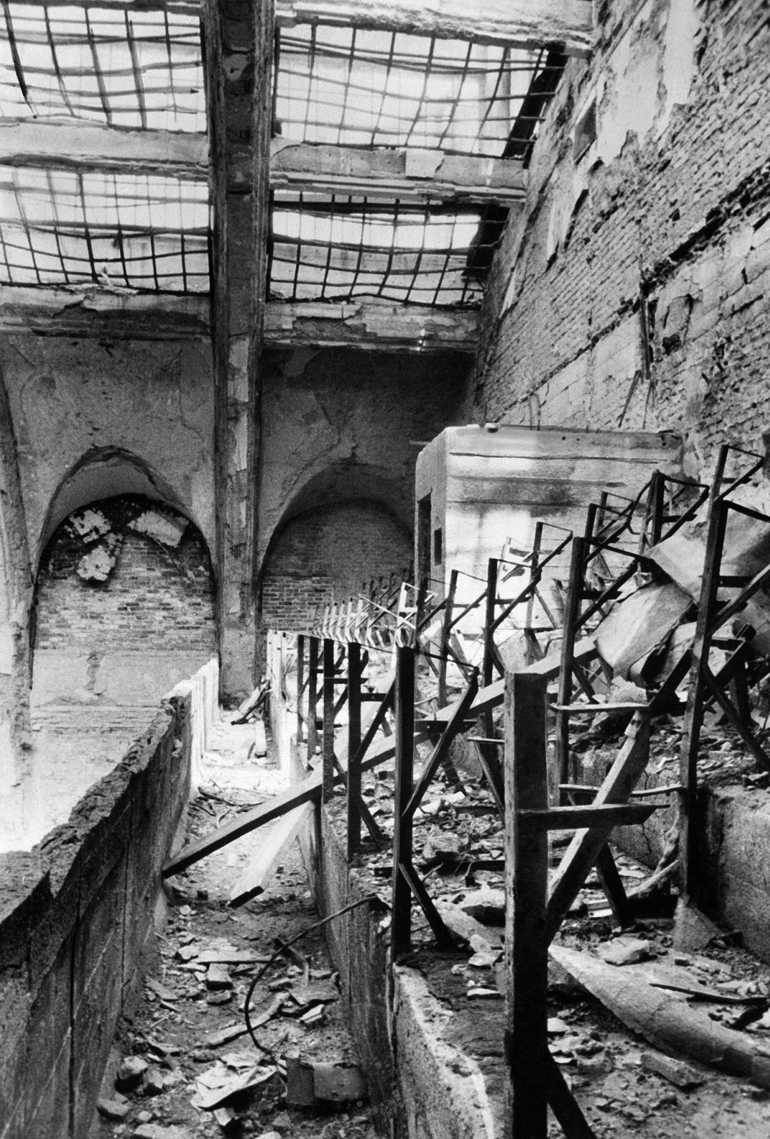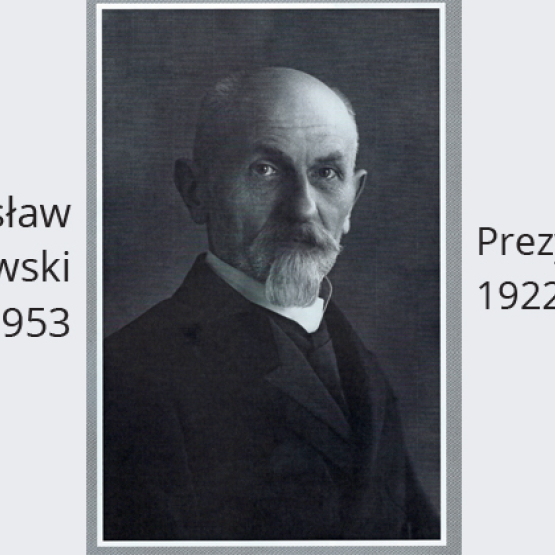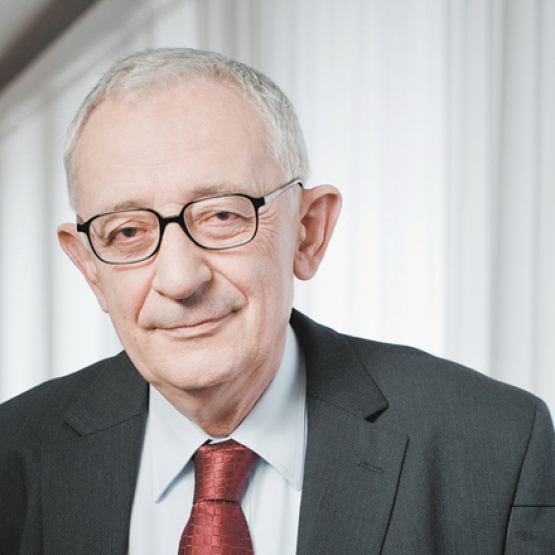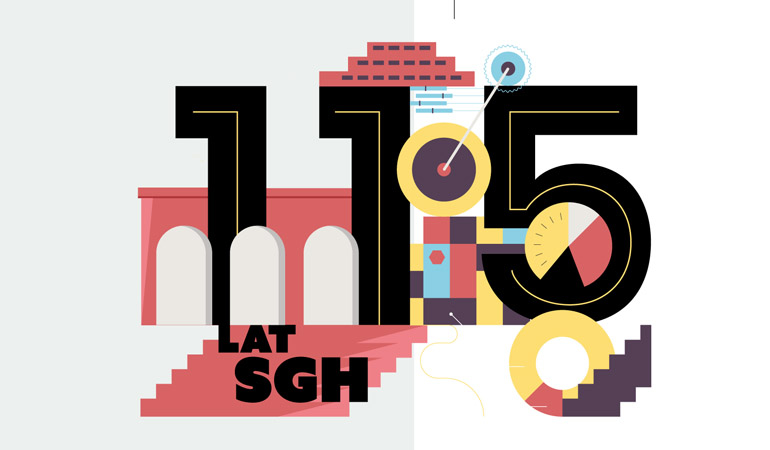
The History of SGH Warsaw School of Economics – Part II. The power of the 1930s and the post-war optimism
Today’s name of our university, SGH Warsaw School of Economics (SGH), first appeared in 1933 when the Act on Academic Schools of 15 March 1933 (Journal of Laws of 1933, No. 29, item 247) changed the name of the Higher School of Commerce (WSH) and granted it full rights of state-run academic schools.
1906–1908 August Zieliński’s Private Courses of Commerce for Men
1908–1915 August Zieliński's Higher Commerce Courses
1915–1933 Higher School of Commerce in Warsaw
1933–1940 Warsaw School of Economics
1940–1941 Economic Courses
1941–1942 Municipal School of Economics
1942–1943 Municipal School of Economics of II degree
1943–1944 Municipal Courses of Commerce
1944–1945 Academic Courses in Częstochowa
1945–1949 Warsaw School of Economics
1949–1991 Central School of Planning and Statistics in Warsaw
od 1991 SGH Warsaw School of Economics
UNIVERSITY ORGANISATIONAL STRUCTURE IN THE 1930s
Pursuant to its statute, the Warsaw School of Economics was a single-faculty institution which offered its students options to study in the following fields: general economics, commerce and banking, taxes, local government, insurance, foreign service, cooperative and teaching.
The Statute of 1934 allowed the formation of research units. By 1939, six such units were established: 1) Political Economy Unit, 2) Statistics Unit, 3) Economic Geography Unit, 4) Commercial Sciences Unit, 5) Social Policy Unit and 6) Technology Unit. Academics would engage in numerous studies.
Cornerstone laying ceremony for the construction of Experimental Pavilion (Building A) attended by prof. Bolesław Miklaszewski (third from the right in the first row), the then rector of WSH. The second from the right is prof. Bolesław Markowski, Treasury Vice Minister, the honorary Chairperson of the Reconstruction Committee, WSH Rector from 1928 to 1929. Antoni Sujkowski, the Minister of Religious Denominations and Public Enlightenment, WSH Rector from 1929 to 1931 (14 June 1925) standing in the background (second from the right)
Rectoral authorities from 1925 to 1940
The following persons held the rector’s position in pre-war period and in 1940:
-
Bolesław Miklaszewski (1925–1928 i 1932–1937) – chemical engineer, WSH cofounder;
-
Jan Dmochowski (1928 r.) – he lectured on economics, industry organisation and administration, organisation of enterprise and cooperative business;
-
Bolesław Markowski (1928–1929) – he lectured on fiscal law at WSH; Vice Minister of Treasury;
-
Antoni Sujkowski (1929–1931) – he was part of the Polish delegation to the Versailles Peace Conference, in 1926 he was the Minister of Religious Denominations and Public Enlightenment, since 1919 he lectured on Poland’s economic geography and political geography;
-
Aleksander Jackowski (1931–1932) – he co-authored the esteemed Commercial Code of 1934, he lectured on commercial law;
-
Julian Makowski (1937–1940) – since 1906 he lectured on economic geography and since 1910 - international public law. He had a career in diplomacy both in the inter-war as well as post-war period.
ACADEMIC DEGREES SINCE 1931
The first academic degrees of a doctor of economic science were conferred by the school as early as in 1931. The first holder was Stanisław Rychliński, who defended a dissertation entitled “Organic Work in the Kingdom of Poland” (supervised by dr Ludwik Krzywicki). In the same year, three months later, Jadwiga Mrozowska obtained a doctoral degree for her dissertation entitled “Saar Basin” (supervised by prof. Antoni Sujkowski). The first doctors also included: Jan Wiśniewski (“Seasonal Fluctuations in Construction Industry”, 1932), Aleksy Wakar (“Labour Wage Theory”, 1934), Andrzej Grodek (“Piotr Maleszewski and his Social Science”, 1934).
In 1930s, the following scholars obtained their post-doctoral degrees: Stanisław Rychliński (1932), Jan Wiśniewski (1934), Aleksy Wakar (1935), Andrzej Grodek (1936), Jan Łazowski (1936), Jan Drewnowski (1938) and Leon Koźmiński (1938).
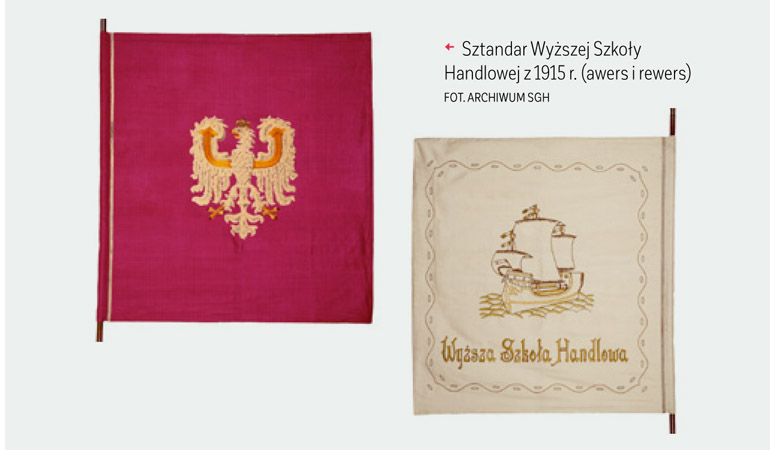
The Banner of the Higher School of Commerce in Warsaw from 1915 r. (front and back)
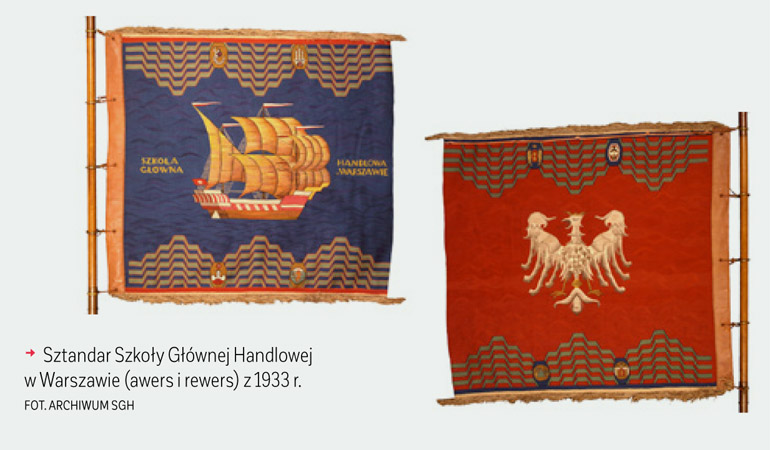
The Banner of the Warsaw School of Economics from 1933 r. (front and back)
STUDIES IN PRE-WAR SGH
Studies at the Warsaw School of Economics lasted six semesters. Upon graduation – after the Senate of the Warsaw School of Economics approved the master's thesis and the student passed the examinations (general and master's) – the student received a master's degree in economic and commercial sciences. Holders of the master of science degree could apply for the title of doctor of economic sciences.
In the academic year of 1933/1934, the general examination was passed by 241 students and the diploma exam by 202 graduates. Four degrees of master of economic sciences and one degree of a doctor of economic sciences were awarded. In the academic year of 1934/1935, the general examination was passed by 196 students and the diploma exam by 185 graduates. Twenty-two degrees of a master of economic and commercial sciences and four degrees of a master of economic sciences were awarded. Subsequent academic years saw a gradual rise in the number of persons awarded the degree of master of economic and commercial sciences.
Each year, the Warsaw School of Economics would grant scholarships for “diligent students of limited means” as they came to be described. In the academic year of 1938/1939, the total amount of scholarships and benefits disposed of was 151,905.20 zlotys. The largest funder of scholarships and benefits was the Ministry of Religious Denominations and Public Enlightenment which allocated 42,000 zlotys to scholarships and loans for 81 students. The funders also included: the National Culture Fund (17,800 zlotys), SGH Warsaw School of Economics Alumni Association (17,550 zlotys – scholarships for studies abroad), Student Dormitories Foundation.
As early as in the inter-war period, alumni reunions became a special form of contact between the university and the alumni. At that time, three such reunions took place: 1st – from 30 to 31 October 1921, 2nd – from 18 to 20 May 1929, and 3rd – from 26 to 27 May 1938.
3rd Alumni Reunion from 26 to 27 May 1938
TEACHING UNDER GERMAN OCCUPATION
On 22 June 1940, the Senate of the Warsaw School of Economics held its last meeting before its liquidation by the Nazi authorities.
However, the outbreak of war and the years of Hitlerist occupation did not interrupt the activities of the university which came to function under such names as: Economic Courses (1940–1941), Municipal School of Economics (1941–1942), Municipal School of Economics of II degree (1942–1943), Municipal Courses of Commerce (1943–1944). The City School of Commerce was independent financially as it received a subsidy of 100,000 zlotys a year from the City Council.
Professor Edward Lipinski inaugurating the academic year at the clandestine SGH (under the name of the City School of Commerce) during the Nazi occupation
The head of the schools was Edward Lipiński with Aleksy Wakar as his deputy. Edward Lipinski had been affiliated with the Higher School of Commerce Iin Warsaw since 1923, lecturing on business cycle theory, economics and the history of the economy and economic thought. Aleksy Wakar was a graduate of WSH from which he earned his doctoral and post-doctoral degree and obtained the position of professor extraordinarius. He lectured on international exchange.
The school, which was run under clandestine conditions, changed class locations on numerous occasions. The curricula were adapted to various levels of teaching, yet many students secretly followed a curriculum which resembled that of SGH.
Following the Warsaw Uprising, in November 1944, prof. Edward Lipiński (in cooperation with Stanisław Gorzuchowski and Stanisław Skrzywan) organised Academic Courses in Częstochowa (1944-1945). Around 100 persons enrolled in a course of November 1944.
Over the entire war history, the university educated around 900 students. Many of them were active in the Polish Underground State and took part in the Warsaw Uprising.
During the war, twenty-four university employees died a natural death or were killed, among them six of the thirteen pre-war professors, members of the WSH/SGH Senate. They were: Maurycy Chorzewski – lectured on the science of commerce, education in vocational schools; Konstanty Krzeczkowski – creator and long-time head of the SGH Library, lectured on social policy and municipal policy; Ludwik Krzywicki – founder of the Institute of Social Economy, lectured on the history of economic doctrines, history of social doctrines and history of economic development; Zygmunt Limanowski – lectured on statistics and demography; Boleslaw Miklaszewski - the first rector, lectured on chemistry and technology; Antoni Sujkowski – rector, lectured on economic geography.
During the September warfare, the university buildings remained unscathed, however, after the Warsaw Uprising, Building A in Rakowiecka Street was burned down in November 1944. SGH Library did not suffer much (the library building and the book collection survived).
Experimental Establishment Pavilion (Building A) – Hall A destroyed after the Warsaw Uprising
POST-WAR RECONSTRUCTION AND RELAUNCH OF FULL-TIME TEACHING
On 28 March 1945, the first sitting of the Senate authorities took place in Częstochowa, where Academic Courses had been held since 1944. Prof. Jerzy Loth was elected the rector. He held the position in the academic year of 1945/1946. He had been with the university since 1917 lecturing on economic, regional, colonial and political geography, as well as the history of geographic discovery and anthropogeography. He also conducted research in Central America and Africa.
On 24 April 1945, classes began in the surviving library building in Warsaw. At the same time, the reconstruction of Building A was soon embarked on. On 1 October 1945, the first post-war inauguration of the academic year of 1945/1946 was held in the already rebuilt Building A. The enfilade-arranged benches were filled with students. The podium was occupied by the Academic Senate and government delegates: the Minister of Public Administration and former Prime Minister of the Provisional Government Edward Osóbka-Morawski and Treasury Minister Konstanty Dąbrowski. Prof. Jan Drewnowski delivered the inauguration lecture (“The Direction for Poland’s Economic Development”) and Stanisław Skrzywan, the Chairperson of the School Building Reconstruction Committee, reported on the committee’s activities. An inauguration speech was delivered by the rector, prof. Andrzej Grodek. In this way, a new chapter in the history of the SGH Warsaw School of Economics began.
dr BARBARA TRZCIŃSKA, Department of Economic Geography, Collegium of Business Administration, SGH


